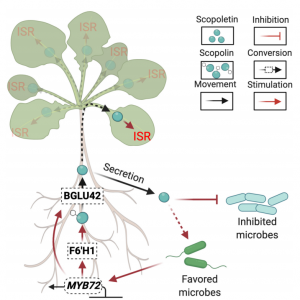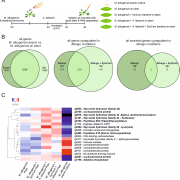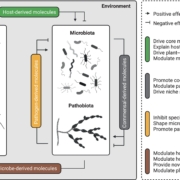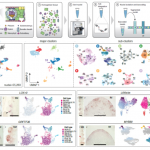Review: Coumarin communication along the microbiome-root-shoot axis (Trends Plant Sci.)
 As the realm of microbiology expands, we see increasing ways in which eukaryotes depend on their microbiomes. For instance, in animals, the “microbiome-gut-brain axis” connects gut microbiota and the nervous system and influences a range of activities from digestion to mental health. Stassen et al. build a parallel to plants, defining the “microbiome-root-shoot axis” in which plants produce microbially-induced phytocompounds to communicate and signal for certain actions. Examples of such phytocompounds include strigolactones, which recruit fungi to aid in phosphate uptake, and flavonoids, that mediate legume-Rhizobium relationships. The authors, however, focus on coumarins, established antimicrobial compounds that also take part in nutrient uptake and root-microbiome communication. Genetic studies reveal that genes mediating coumarin biosynthesis and secretion are responsive to iron deficiency and are important for plant survival in iron-deficient soils. Coumarins and coumarin-associated genes also seem to play roles in root-microbiome and microbiome-root communication, shaping rhizosphere composition and priming host plants for immune response, as well as root-shoot communication. The authors conclude with a parallel to the animal central nervous system, noting that future experiments regarding coumarin functions “should aim to elucidate how these root-derived ‘neurotransmitters’ affect the aboveground plant ‘brain’ to ultimately exploit the function of the ‘inverted gut’ microbiota and achieve optimal plant fitness.’” (Summary by Benjamin Jin) Trends Plant Sci. 10.1016/j.tplants.2020.09.008
As the realm of microbiology expands, we see increasing ways in which eukaryotes depend on their microbiomes. For instance, in animals, the “microbiome-gut-brain axis” connects gut microbiota and the nervous system and influences a range of activities from digestion to mental health. Stassen et al. build a parallel to plants, defining the “microbiome-root-shoot axis” in which plants produce microbially-induced phytocompounds to communicate and signal for certain actions. Examples of such phytocompounds include strigolactones, which recruit fungi to aid in phosphate uptake, and flavonoids, that mediate legume-Rhizobium relationships. The authors, however, focus on coumarins, established antimicrobial compounds that also take part in nutrient uptake and root-microbiome communication. Genetic studies reveal that genes mediating coumarin biosynthesis and secretion are responsive to iron deficiency and are important for plant survival in iron-deficient soils. Coumarins and coumarin-associated genes also seem to play roles in root-microbiome and microbiome-root communication, shaping rhizosphere composition and priming host plants for immune response, as well as root-shoot communication. The authors conclude with a parallel to the animal central nervous system, noting that future experiments regarding coumarin functions “should aim to elucidate how these root-derived ‘neurotransmitters’ affect the aboveground plant ‘brain’ to ultimately exploit the function of the ‘inverted gut’ microbiota and achieve optimal plant fitness.’” (Summary by Benjamin Jin) Trends Plant Sci. 10.1016/j.tplants.2020.09.008









